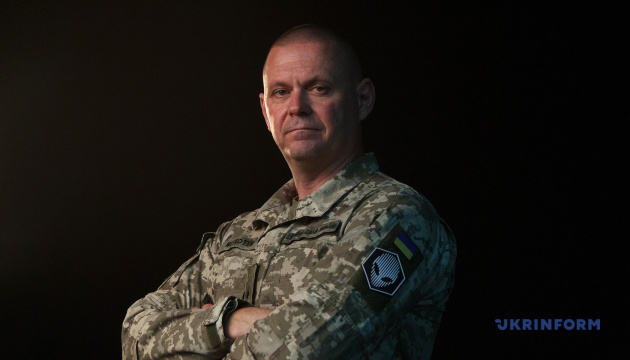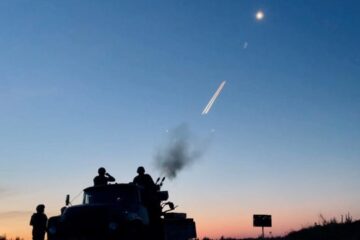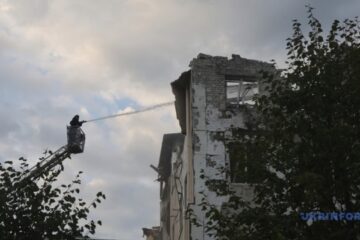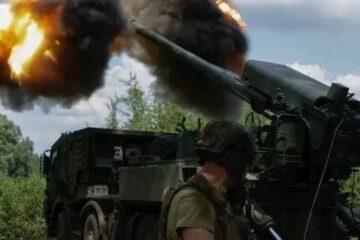Soldiers under his command have been holding the frontline along its full length from Kharkiv Oblast to Kherson Oblast regions. Anatoliy Merkotun devoted more than 20 years of his professional career to serving in law enforcement; during the ATO anti-terrorist operation he served as part of a special operations unit. Anatoliy took up arms immediately after Russia invaded Ukraine in February 2022. He was policing the streets of Kyiv in the first days of the full-scale war. Currently in the rank of Lieutenant Colonel, he commands the 412th Nemesis Separate Unmanned Systems Regiment which is deployed in the hottest frontline areas.
For this Victory Commanders series interview Ukrinform sat down with Anatoliy Merkotun to talk about drone technology development in Ukraine, the most hellish sector of the frontline he fought in, and about his personal formula for success: how to achieve results in an ever changing battlefield.
[embedded content]
– How many years have you been in the military?
– Since the beginning of the full-scale invasion. Before that, I served with law enforcement for a long time, more than 20 years, was engaged in detective-investigative operations among other activities. Then followed civil service: at the beginning of the full-scale invasion, I was employed in [Ukraine’s state-owned weapons industry holding] Ukroboronprom.
– And during the ATO [Anti-Terrorist Operation]?
– I was deployed in the ATO from its first days, serving as part of Phantom special force. We were deployed to combat operations on the contact line along its full length at that time. The main focus was on the Kurakhove sector, then others followed. Our key task was to monitor the movements of prohibited substances across the contact line, as well as to work at checkpoints. We had mobile teams organized jointly with other defense and security institutions, such as the Security Service (SBU), Border Guard Service, and Police.
I was in charge of one particular sector, and later promoted to command a combined task force. Needless to say, there were special conditions for training there, we were always very well equipped. But it was a tactical edge, where even GPS navigation worked not everywhere and not always back then, so we often had to move by maps; at night hours, we happened to drive to a wrong place or turn to a wrong position, there were no clear landmarks, because everything was very mobile and dynamic. It was a service that was a little different from the others, with different tasks, an interesting experience. I served one rotation there, and then continued with my law enforcement service.
– And what can you say about your first combat experience, the one on the contact line? Do you remember how it was for the first time?
– What I remember best is the town of Maryinka in the Kurakhove sector. During the so-called May holidays (the war criminal Motorola was still alive then, if you remember, there was one such in the [separatist] DPR), offensive actions were actively prepared for, timed to these holidays. And so our unit found itself in the very epicenter. It all started with a very heavy artillery shelling at dawn, our guys were deployed to positions, near the checkpoint and others. Certainly, there were relevant forces in place, holding back the assault. But then — what impressed me so much, and from that time on I began to respect the Armed Forces — a few hours after these intensive enemy offensive actions began, a unit of airborne assault troops arrived. And I remembered it so clearly: spring 2015 –and there were no tablets, no Starlinks, nothing at all back then – a guy is sitting holding four walkie-talkies in his hands. Our military is already on the offensive, entering that town from three different directions, kicking out illegal separatist formations. And that guy, simply keeping the entire situation in his mind, without looking into the map, without any prompts, led actions in all of these three directions simultaneously, giving instructions to commanding officers in the field. After the operation had been over and the enemy pushed out, I came up to him and said, “Listen, it was really awesome, I’m fascinated.” He inquired, “Who did you study to be?” I replied, and he told me: “I studied to be a soldier, this is my profession.” I started to respect him so much, there are really cool guys among us.
– How did it impact you?
– You know, I would not say it had an impact on me, but it definitely boosted up my confidence, because we constantly hear wailing like everything is lost, we have nothing left, everything has been stolen – and then such a story happened where everything depends on people. The people who are on the ground, those who are just working without looking around, who don’t look for betrayal, don’t faint from what’s happening around them, but do their job, and if they do it professionally, they achieve the desired results and energize everyone around them.
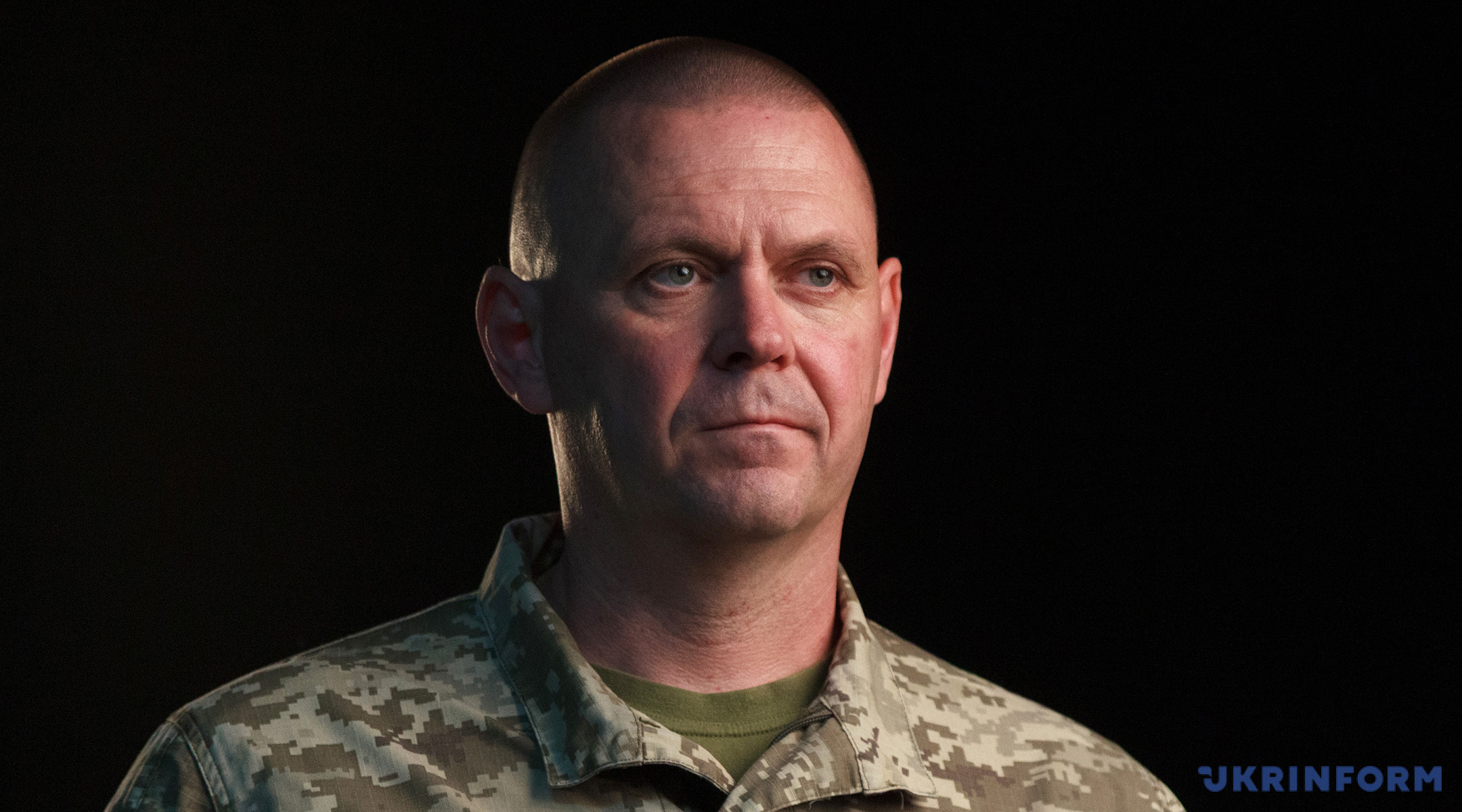
– A lot of volunteer soldiers have come with civilian specialties, and, at the same time, there are career soldiers as well. Could you tell from your experience if there is a difference between these two categories of soldiers?
– Career military men comprise less than ten present of our unit, the remainder being civilians who never thought of joining military ranks, nor did they have experience in law enforcement. They came from business, from the media world, it raises your eyebrows when reading their sign-up questionnaires. And this is quite important, in my opinion. That is, it is our creativity, because what we were doing was guided by the logics, by common sense, reasonable processes were built, and this came from civilian life. I think this was what helped us survive; we are holding on now, and we believe that we will prevail. That is, any division between career soldiers and non-career soldiers, if it ever existed, has already been nullified (I am speaking for my unit, I don’t know for others). What helps us is that the regular military personnel have a knowledge base on how to handle documents – you know, they remain in place, all these war diaries, property write-offs. Everything must be documented in a way prescribed by regulatory documents, and they help with this, share their experience. Civilians, for their part, are bringing in business ideas, building the appropriate processes, KPIs (key performance indicators, – ed.), modifying and updating analytical components. This all is integrated together, bringing the desired result.
– What was the beginning of the all-out invasion like for you, how well prepared were you for this challenge?
– I, like everyone else, didn’t want to believe it, because the logic and common sense said that it was impossible, unrealistic, there was no point in it, why, why… I remember well a telephone conversation I had with my mother the evening before the full-scale invasion. I called her (for some reason I felt like it), we were talking, she asked why I was calling, I said: “Something is so disturbing.” I am not very sentimental, it’s not often that I call someone, usually on business only, but for some reason I wanted to talk so much and went to bed with a feeling of relief.
When the first explosions sounded, I woke up with a clear understanding of what had begun, took my family to my parents’ home village and returned to Kyiv, where the guys with whom we served together in the Phantom regiment had already begun coming gather. And then a free formation began to be organized, it did not yet have legal status. Cossacks who knew what to do just gathered together and started arranging things – liaison and communication, hunting weapons, bulletproof vests, unloading gear, backpacks, whatever we needed.
I served as a driver in the rank of a private until I passed the certification. There is such a procedure in the Armed Forces – re-certification, that is, when a special rank is re-certified into a military one. At that time, pending this re-certification, there was a driver’s position, which, reasonably enough, presupposed certain responsibilities. We performed tasks policing specific areas in [Kyiv’s] Podil District which were assigned to our unit. These were the initial days, we were holding certain point areas. Afterwards, our unit was reorganized and expanded into a Company, also designed for special missions. Integrated from our unit, it ultimately grew into a Battalion – a special operations force that performed the tasks assigned to our unit by the Security Service of Ukraine, including particularly sabotage countermeasures. At that time, there were lots of operations held with special technical means deployed to various locations, including the Belarusian border; then followed other deployments, Bucha and Irpin among them.
And at some point, drones began to be actively deployed, first Mavics, followed by agricultural drones. And after the first agricultural drones came into play, our military team was set a special task to provide security for the operators piloting these heavy bombers. That is to say, a different tactic was in use back then; there was no stable frontline, it was unclear where the enemy was or was not, the situation was dynamic and subject to change. And for each pilot who was flying an agricultural drone, bomber or other, his position had to be checked for security vulnerabilities, then guard and patrol posts had to be set up to safeguard against sabotage and other malicious activities at the time an operator is piloting the drone. You know, the men had to be concentrated, without the need to pull their focus away from their work. And we began to compile each individual group of pilots — a special unit which was to bring this all to positions, provide security, conduct reconnaissance and logistics support. And this was what our military unit began to do.
– Does the feeling of being in a position as a private help you in your current work as commander?
– I don’t know, you should better ask the guys I command (I am joking). But, indeed, I think that the feeling and understanding of everyone who joins the military unit, regardless of their positions or what they do, is that they are treated as humans in the first place and that I have feedback – this is one of the key principles our unit is guided by.
– Are you going out to the guys’ positions?
– I visit the positions once in a while. I go there accompanied by commanding officers, because there are lots of organizational issues that need to be addressed. And, in principle, where a unit’s commander goes out to a position, that means that either the organization is not working as appropriate, that something needs to be updated, or he wants to set a good example to his subordinate soldiers. At the moment, thank God, everything is working well, so it doesn’t come to this, but this feeling of a commander being present in the field should always be there.
Our unit is special, it doesn’t work in one single lane, that is, we are now present all the way along the contact line: from Kharkiv region to Kherson region, our composite groups are working everywhere. That is, we continue to carry out special tasks being the kind of a special operations unit, so we have to be deployed from time to time to each section of the frontline, and I am working to ensure this is so. Additionally, I encourage staff officers, whoever can, to come, speak to the guys, be present on positions.
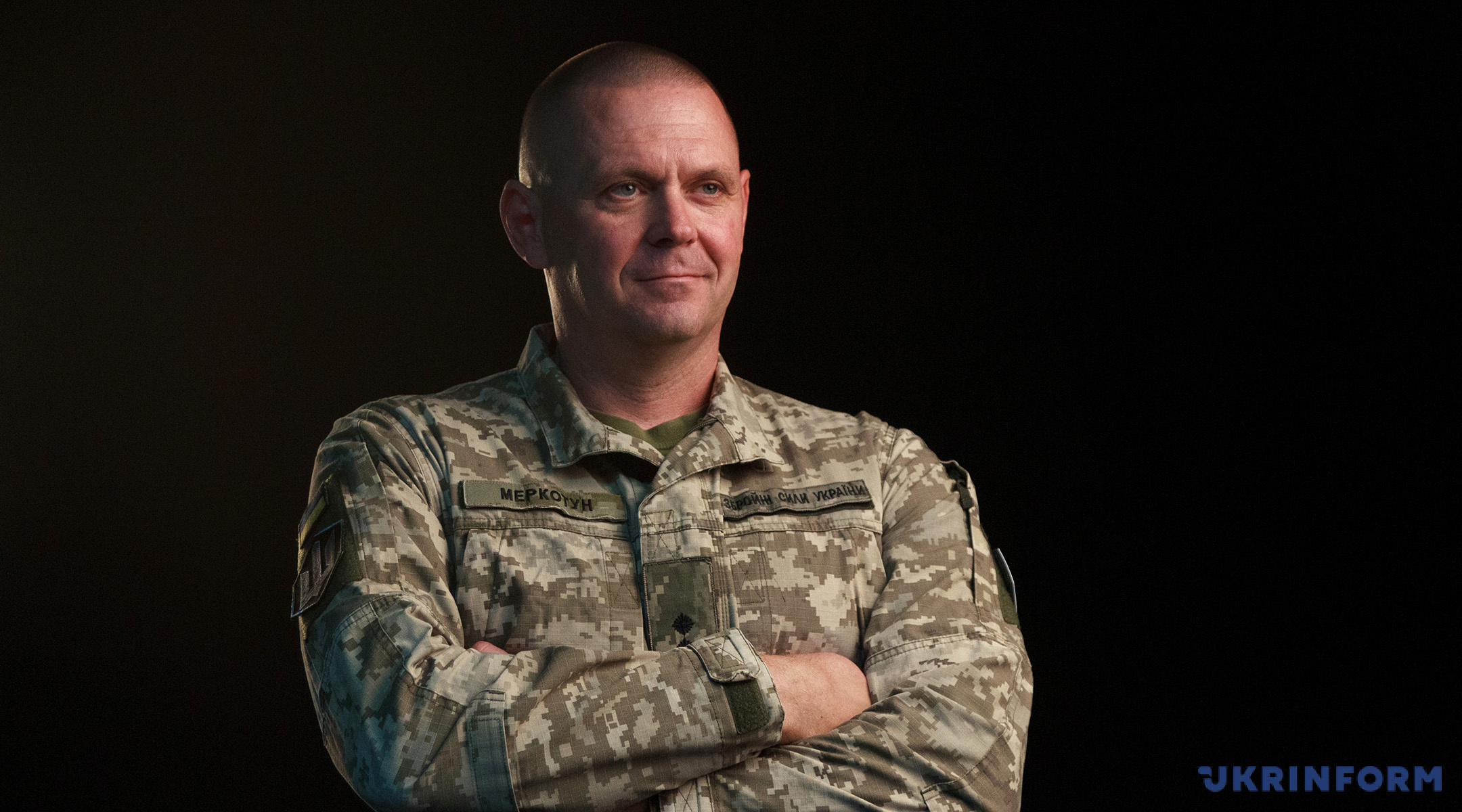
– Could you tell us a little more about management in your unit?
– Let me begin with how the Nemesis Battalion came to be. Why Nemesis? We have an unmanned vehicle – a night bomber, the enemy calls this class “Baba Yaga”. This night bomber drone was reconfigured from an agricultural drone. It was redesigned and modified to become completely different from the original design. And these vehicles are currently employed by different units. An effectiveness review conducted by the General Staff after six months since it came to be revealed that the guys from our unit are most effective at using it. That is, with the minimum number of lost vehicles, they inflicted maximum damage on the enemy – lots of sorties, lots of successful hits, awesome results. And I was the one who was involved in this all as deputy Battalion commander for operations. Then the General Staff decided to organize a separate unit that would deal specifically with night bombers, absorb the best practice, best experience and expertise, and then share this across troops.
They offered me the position of commander, we switched from Territorial Defense Forces into the Armed Forces, and began to build this organization. At first, there were five of us. We sat on benches in a park, literally, writing this stuff, the functions it was supposed to perform. We were lucky to be deployed as part of the 101st Guard Brigade of General Staff, which is pretty renowned across the Armed Forces, and both the Brigade commander and officers helped us a lot. Honestly, I was surprised, because, typically, when someone approaches you and you have to help them organize and deploy, no one likes it, it is an unnecessary burden, no one it in the military likes it. But they accepted us as relatives, we are still friends and help in organizing military events.
Thus, we began the deployment, and the main UAV class we began to work with was the Nemesis – a heavy UAV bomber capable of carrying 10+ kg payloads to a distance of 30 kilometers. We continued to work with it, and at a certain point, when the Battalion was already brought up to 80–90 percent of full strength, the need arouse to expand and change our specialization a little bit. Then the decision was made to expand the Battalion into a Regiment. So, we are currently serving as part of the 412th Nemesis Separate Unmanned Systems Regiment. We already have not only heavy bombers, but also reconnaissance drones, FPV drones, ground robotic platforms, even a naval subdivision equipped with naval unmanned vehicles. And this all is networked within an integrated system of combat management and coordination – a very potent analytical component. We analyze everything we can, ranging from the number of sorties and successful hits, the munitions used, which of them worked and which did not, how quickly the logistics arrived. We have built a robust core structure, the main command post, and began to build up various capabilities based on this structural management unit. And this all is working today.
– If I understand right, analytics and metrics are a must-have in your work?
– One of the main ones. The guys work very hard, they came from international analytical companies, they brought a whole culture into our military organization. At meetings, they present their dashboards showing what it looks like, different data, how they are integrated, how certain numbers affect others, as appropriate. And what means the most is that these are not just numbers for the sake of numbers, we learn lessons this all and improve our work, starting from how logistics should work, how long it takes to get a drone, register it, deliver it to the troops, test fly, install new software and deploy it to positions; how much work the guys have to do to get it ready to takeoff, deliver its bomb payload and return safely. This is calculated and constantly improved. Our effectiveness and efficiency, and our success formula in general is that we constantly explain to the guys who, what and when needs to do.
– How accurately can you calculate everything amid war? Maybe it depends on specific scenarios or situations? Is there room for improvisation?
– It is impossible to calculate everything accurately, but planning and calculating our capabilities is a must. That is, we must take account of different scenarios, of the highest risks facing us, most particularly the risks to personnel, which is our first priority. On top of that, the commander is always empowered to make decisions he sees fit for achieving the desired results, especially where he has a better vision of the situation than a higher headquarters, for example. It is thus impossible to calculate everything, but there are main planning milestones, and this is mandatory.
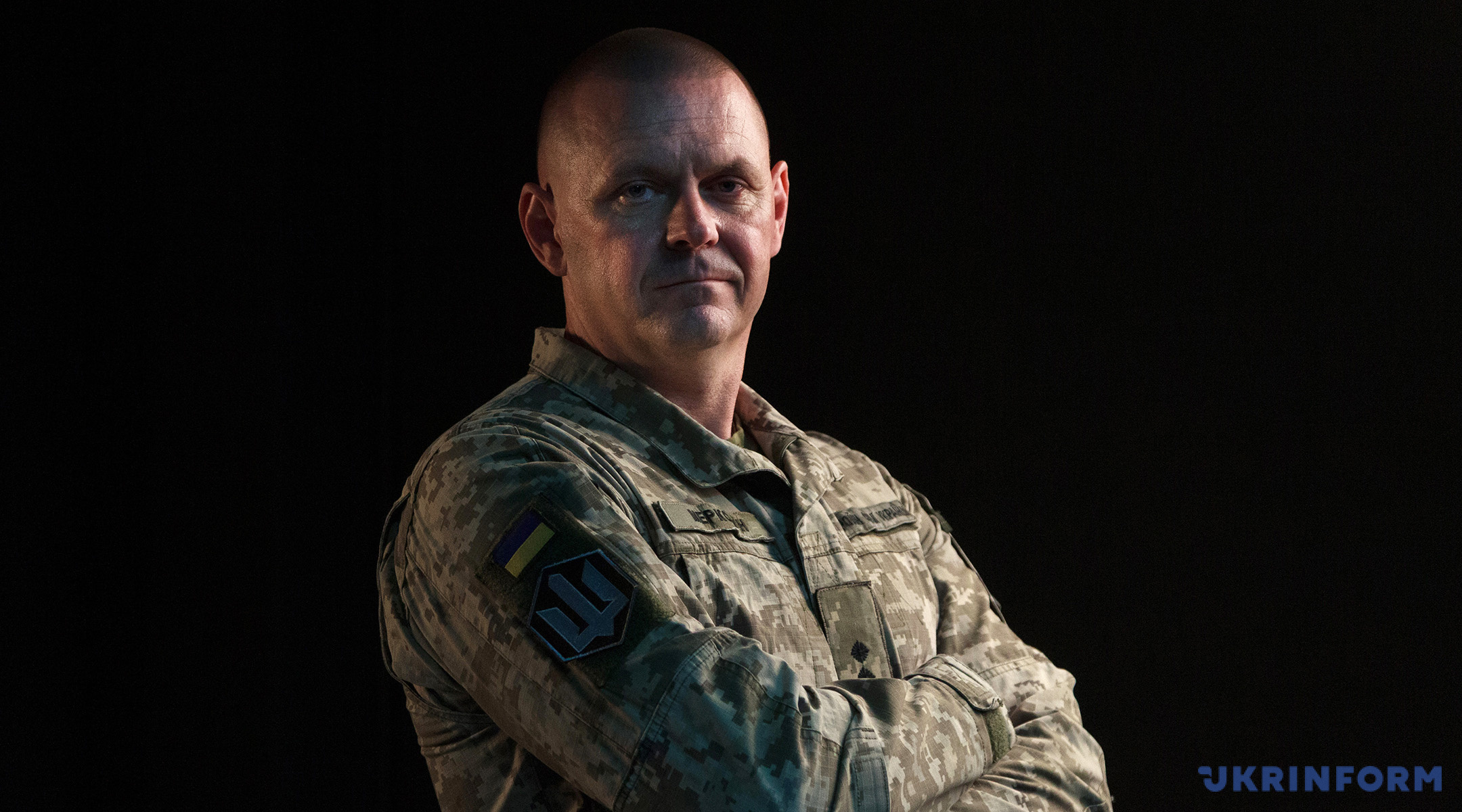
– Looking back, when there were five of you, what made you feel, see the promise in UAV technology and understand the need to develop in this domain?
– Everything happened naturally. I wouldn’t say I just sat down and suddently felt that I want to be engaged with drones. We all were tailored for what we knew or were able to do, what we learned while undergoing training and then serving in ATO operations. We saw how the guys were working with drones, how effective it is where a device worth several thousand dollars destroys equipment worth several million dollars, and this can be systematically used and scaled up. It was then when I was fascinated about drones.
I remember the first such interesting impression. I got to the dean at an aviation university, and said, “We want to make drones.” And he took me to the laboratory; I wish you could see the poor equipment it had. And he says, “There is no one out here, except three of us are sitting, gluing something out of plywood, because we have no funding, no components, nothing.” He gave me a list of people, saying, “This one is smart, he knows a lot about communications, and this one knows a lot about aerodynamics.” We gathered them in the office to discuss one single task – to integrate a certain communication system onto a drone.
And I remember two such funny moments. We are driving with my deputy (he now serves with my unit), and I say, “Look, there is an idea to integrate such and such type of communication system onto a drone to enable it to be controlled remotely.” He replies, “I talked to everyone, among them academicians, radio engineers; it is impossible in principle, it does not really happen, it is full of a bunch of limitations.” But we ultimately got it – the main type of communication system we use on these drones. I constantly remind him of that, saying “Do you remember, you never believed this would work?
And the second moment: All these engineers arrived and gathered in one room. There is a drone. The idea was like that: there is a drone, and the challenge is to get it scaled up. And they are walking around it with their eyes squared. And the guys, a team of young radio engineers did it. And then I had such a clear feeling of how far our engineering science was from the realities of the time. And the team of enthusiasts from a small ready-center began to design and develop, to improve. There are several such strong teams that were working before that, and the first drones began to appear – high-quality ones. Of course, there were lots of questions, problems, continuous modernizations; you know, this is an ever evolving process. The adversary is constantly inventing countermeasures against communication systems on our drones; these are electronic warfare countermeasures, that is, we use one particular frequency, and it no longer works in a short while, it is jammed, then we switch to a different frequency. This war between Shield and Sword, let’s call it that way, is never ending. But it was clear right then, based on the first results, that it was really awesome and could be scaled up, which is what we started doing.
– Could you tell us about a successful operation you are most proud of?
– To date, we already have a lengthy history of sorties; we have so far logged more than 12,000 or even 13,000 successful target hits, some were reported by our special media outlets. For example, we were the first to hit a North Korean self-propelled artillery gun Koksan, we have it recorded on the video. Besides, we have to our credit quite a lot of successful strikes on hostile air defense assets, including particularly high-valued Buk systems.
One of the very first operations was very interesting. There is a self-propelled heavy mortar system such as Tiulpan, and it caused a lot of trouble to the guys deployed in a position in the Kharkiv region by constantly shelling it. We were tasked to engage it. We tracked it down, fully loaded. And when our drone dropped its load of ammunition on it, there was a detonation – very beautiful, flashy, ostentatious. This is one of my first brightest impressions. Such successful operations are pretty numerous. We have already reported what we were allowed to, and what we cannot report yet will definitely be reported after our victory.
– You said you are deployed in almost all sectors of the front. What can you say about the current frontline situation in general? Which of the sectors is most challenging, the hottest for you now?
– Pokrovsk is the most challenging sector, indeed. The enemy keeps pressing with offensive in and around Pokrovsk. As far as our unit is concerned, we are facing extremely heavy electronic warfare counteraction, which makes it very hard to fly drones and carry out tasks at hand. The enemy has become more aggressive in the Zaporizhzhia sector, assaulting primarily with infantry, without mobile armor support, in small groups. We are vigorously countering their push with the help of FPV and bomber drones with various range and payload capabilities. Besides Pokrovsk, we are also present in the Kupyansk and Kharkiv sectors. The adversary is pressing its offensive with increased urgency, all the way along the front line.
– What is in more need now — equipment or human resources?
– We are actively recruiting new personnel. Being a commander of a military unit, I can recruit people into the unit directly, i.e. bypassing military enlistment centers. This ensures that a person willing to serve with us cannot be taken away to serve anywhere else, will definitely end up with us. Now we can recruit new soldiers by ourselves without military enlistment authorities being involved, which is a very effective tool.
People are the main resource that we need, and, of course, we fight for everyone, treat everyone with great responsibility. Second, we have organized a basic military training course at the Regiment base. That is, previously, the training was provided at training centers only, and lasted 49 days.
We launched a 30-day basic military training program, and got certified a program that contains elements of basic military training integrated with training in unmanned system piloting. These include familiarization programs with various [combat management] systems such as Delta and Kropyva, as well as training in counter-detection, tactics, radio security, and cyber knowledge. These are all systems of information, situational awareness, they are embedded into the basic military training system to the maximum extent possible. That is, a serviceman, in addition to basic training, is provided with training in specific domains related to our work. This training is provided from our own funds. In this way we are trying to close the shortage of personnel gap and provide for our own needs within the unit as much as possible.
As for logistical support, a mechanism has been launched that allows military units to receive money directly on their bank accounts so that they themselves can manage it and procure everything they need. This is quite effective, and it speeds up everything. Indeed, there are things that still have to be provided by the government, but for the most part, I believe the unit is provided pretty well.
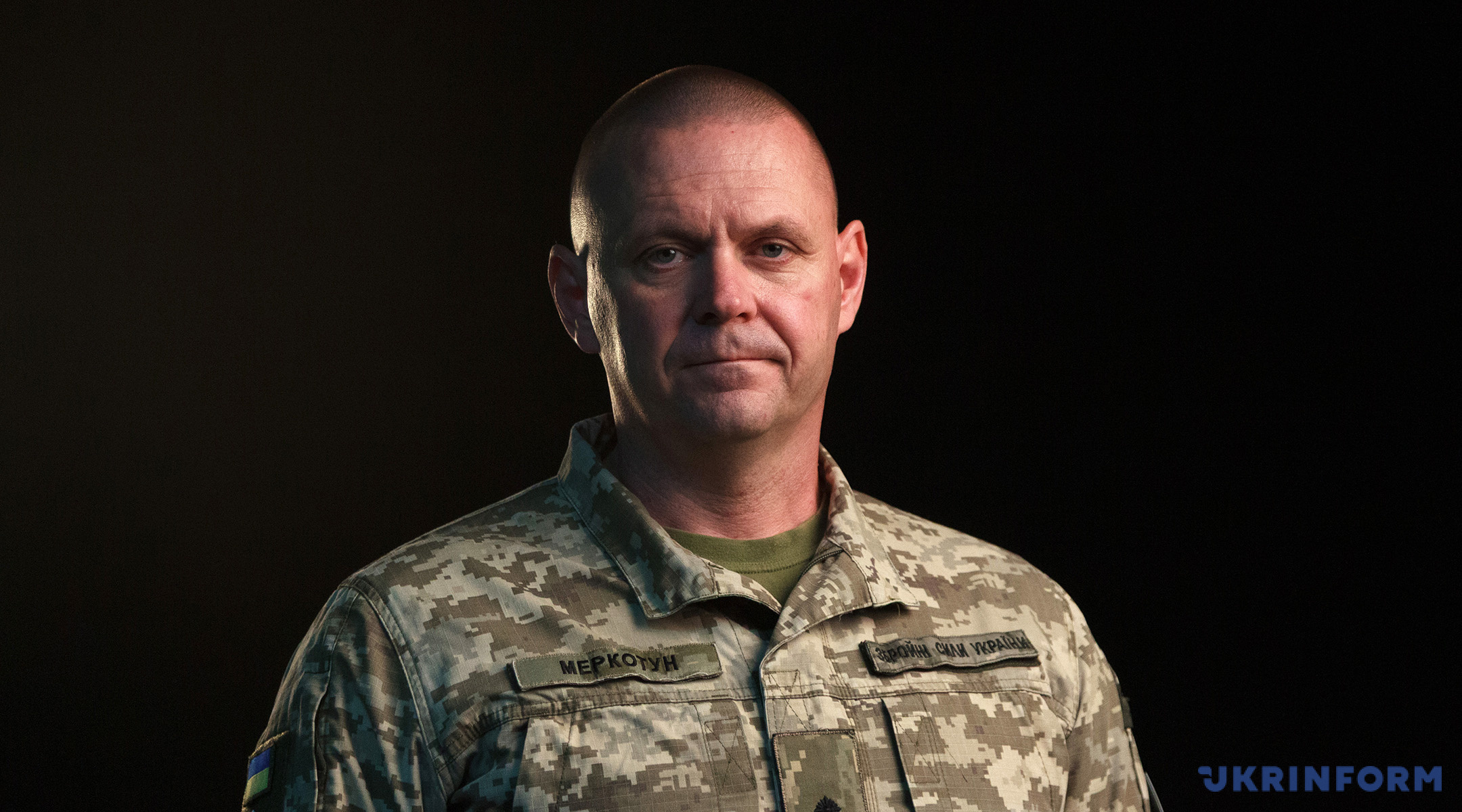
– Regarding the improvements being introduced by the Government…Are there any positive changes and improvements to the system?
– Yes. For example, there is a certain mechanism that has been implemented through Army+ app. Some criticize it, some don’t, but we are happy having it. That is, a soldier can change his duty station if he meets certain conditions. It is very cool, really. Plus, some documents and reports for submission have been transferred into the digital format. It is quite flexible and fast, a very effective mechanism. I am grateful to those who devised and implemented it. Add to this the ability for the commander to recruit military personnel and civilian contractors directly into his unit and independently manage the money on the unit’s bank account.
Now, about the decision that has been talked about for a long time. This affects 18–24-year-olds, a generation of gamers who can click on all iPads and touchpads with their eyes closed. Obviously enough, those guys will be the best pilots. And now, finally, it seems to have been decided that 18-24-year-olds will be contracted specifically for operating unmanned systems. A very appropriate decision! If finally confirmed, it will definitely add cool professional to our ranks.
– Are there those who volunteer to serve in the fourth year of the war?
– Yes, there are. They are all volunteers in our unit, and people are very different. I’ll give you just one example that impressed me much. A 19 years-old guy joined us voluntarily. That is, he was 15 when the full-scale war broke out, and he consciously, independently decided to join the ranks. His eyes are burning. It is clear that it is more about some ambitions, we are trying to rein them a little bit. What is interesting is that this generation of boys who were 15–16 years old when the war began in 2022, they are growing up, and they are already conscious about the need to defend their country. But it is very sad, actually. I look at this young Cossack, and I feel very sad over this happening, feel unhappy that children, boys, instead of going to discos or clubs, are burning with a desire (not all of them, of course) to join the military. But at the same time, it motivates. And now he has gone to the war zone, is still studying, but with the guys who are serving their fourth year at war. I watch how these Cossacks, who are fighting the fourth year now, these uncles are nursing, caring for him, trying to help. And I see that they feel that their work, what they do, is not in vain, and it is encouraging.
Most of volunteers come from the IT domain, they are very creative guys. They have different worldviews from ours, they are a different generation. It is very promising, and if employed appropriately, it is quite effective, especially with respect to unmanned systems.
– My next question is about your plans for the future and development: what do you want to do, change, implement in the short term? How do you see the development of the unit under your command?
There are lots of fascinating unmanned vehicles added to our arsenal, including those designed and manufactured domestically in Ukraine or donated by partner countries, and there are also those which we refine and modify to our needs together with [international] partners. These vehicles are diverse in terms of communication equipment used, effective engagement range, warhead mass etc. That is, we want to try everything, deploy everything.
And there is a request to increase the number of combat crews. To this end, it is necessary to either do some restructuring within the unit, or plan its scaling and growth. We have submitted all our proposals to the higher command. The commander supports us in this endeavor, and thus the request goes to the General Staff. We are waiting for a decision. Be it what it may, we continue to perform the tasks at hand with the capabilities currently available to us. What definitely needs to be done is to organize new subunits and our own R&D centers that will continuously work, aiming to swiftly integrate new UAV technologies to meet ever-evolving battlefield needs. This is about the deployment of new vehicles, new communication systems, new video capabilities… This must be constantly monitored and embedded into combat models. As practice suggests, not everything that flies at the test site will fly as well in combat work on the battlefield.
For example, what makes our unit appealing to manufacturers? Because we provide quick feedback. That is, they give us a tool, and in a few days we already provide feedback on its battlefield effectiveness. Where some deficiencies are detected, it’s not that it just doesn’t work, take it away. Nothing like this. Our engineers say: look, it doesn’t work because this or that needs to be added, you get it rectified and return it to us, we will test it. And cooperation gives birth to innovative, ingenious solutions that are often many times cheaper than the alternatives from partners or something else. Sometimes you are surprised to see how a highly effective solution is made from primitive components.
– What will Ukraine’s victory mean to you?
– For some reason, I don’t think much of this, just do my job, try to think as little as possible about what will happen and how it will l be. Ukraine’s victory… For me, victory will be there when the personnel serving with me now will be preserved as much as possible in the current composition. That is, everyone will remain alive and healthy. We will definitely get a just peace. Peace… It is different for everyone. The bar I set myself is reaching the borders that were set for us, internationally recognized ones. Understandably enough, that it is difficult, complicated, perhaps not at the right time. But we must definitely win by forming such a nation, such a strength, such a people within the country that will be confident in themselves, will understand themselves as Ukrainians, will respect themselves. And everyone around us will know that if they touch us – that’s it, there will be hell to pay. Only life will tell on what territory we will do it, within which borders. But we must build the core of the nation anew. This is now being riveted and done with human lives, the lives of the best people, unfortunately. Well, never mind, we will win, we will overcome and we will definitely form the best nation in the world.
– Thank you.
Diana Slavinska led this conversation
The interview can be watched in full here
Photo: Kyrylo Chubotin
Source: Anatoliy Merkotun, Commanding Officer of the 412th Nemesis Separate Unmanned Systems Regiment

